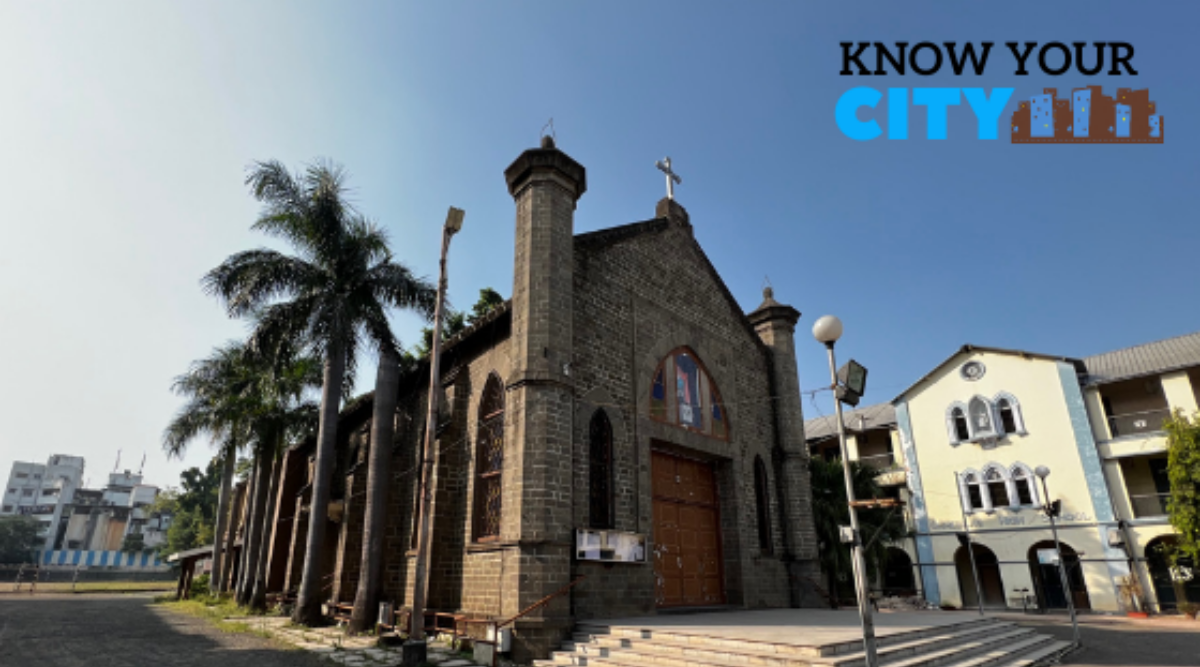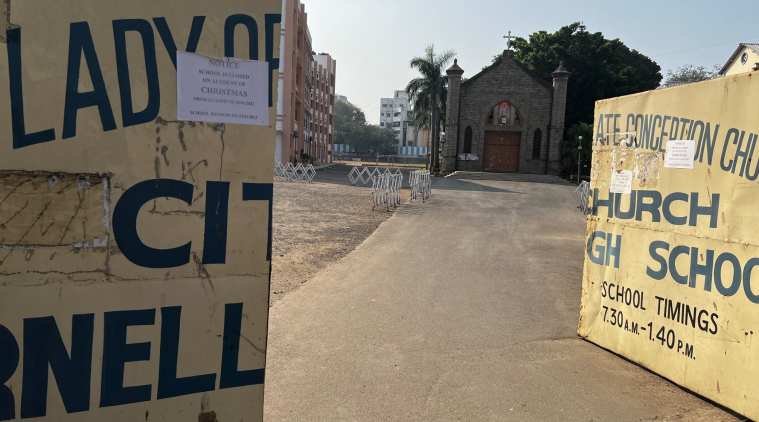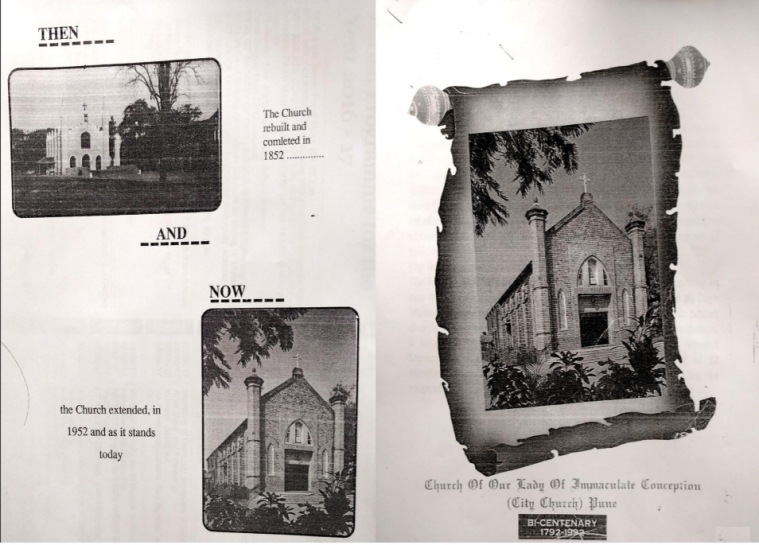 Tucked inside the narrow lanes of Nana Peth, the Church of Our Lady of Immaculate Conception came to be known as City Church for it served as one of the entry points to then Poona.
Tucked inside the narrow lanes of Nana Peth, the Church of Our Lady of Immaculate Conception came to be known as City Church for it served as one of the entry points to then Poona. Pune got its first church way back in 1792 thanks to the generosity of a Peshwa — minister of erstwhile Maratha state — stemming from his desire to beef up the army. The inaugural mass there was held on Christmas day that year and another Christmas day, 229 years later, is a fitting time to revisit the church’s history.
Tucked inside the narrow lanes of Nana Peth, the Church of Our Lady of Immaculate Conception came to be known as City Church for it served as one of the entry points to then Poona. The land on which the church was built was gifted by the then Peshwa Sawai Madhavrao II in appreciation of the services of the Portuguese soldiers enlisted in his army.
At a time when the Peshwas’ powers had appeared to be on the wane, Sawai Madhavrao found a friend in the Portuguese empire in Goa to strengthen his army. The Portuguese and Goan officers who came to Pune needed a place of worship, and the Peshwa promptly gave them land for the purpose.
Church records have it that Dom Minguel de Noronha, a Portuguese national and an officer in Sawai Madhavrao’s army, was the driving force behind the recruitment of soldiers from Goa and North Canara. Noronha garnered monetary contributions to build a church on the land gifted by the Peshwa, who himself pitched in to bolster the kitty.
Soon, a small structure was constructed on the land with only mud and mortar and Fr Vincent Menezes was appointed the first parish priest of the church. The church was reconstructed with stone and mortar later in 1852.
According to excerpts from the book`Poona Guide and Directory’, after the downfall of the Peshwa rule, the British government continued to support the church by listing the reverend among its gazetted officers and paying him a handsome monthly allowance.
On the northern side of the Church is the Ornella’s School founded in 1887 and on the southern side is the Portuguese Association Hall. The graveyard is a short distance away.
On an invitation from the Patriarch of Goa, the Sisters of Apostolic Carmel started the Mount Carmel School in 1943, in a building situated behind the church. The church was extended in 1952 and the next year, the parish came under the Bishop of Poona.
“Though the Marathas were keen to establish the primacy of ‘Hindu Pat-Pat-padshahi’ or the Hindu Empire, it was a fair regime as far as the freedom to profess one’s faith was concerned,” says Sandeep Godbole, chronicler and well-known expert on Pune heritage.
“The Sheikh Salla Dargah in Pune also received patronage from the court of the Peshwas. In fact, around a dozen dargahs in Pune, along with Hindu temples, received donations to celebrate the birth of Bajirao-II’s son. The grant of land for the church needs to be seen in the same perspective where each person was free to profess one’s religion and customs. The emblem of Ornellas High School has the word ‘Jari Patka’ — the Maratha flag– and the Shaniwarwada on it as a remembrance of the grant from Sawai Madhavrao,” says Godbole.
 On the northern side of the Church is the Ornella’s School founded in 1887 and on the southern side is the Portuguese Association Hall. The graveyard is a short distance away.
On the northern side of the Church is the Ornella’s School founded in 1887 and on the southern side is the Portuguese Association Hall. The graveyard is a short distance away.According to Pune Nagar Sanshodhan Vrutta, published in 1952 by Bharat Itihas Sanshodhak Mandal, a monthly grant of Rs 94 was given to the school and the church from 1793, adds Godbole.
The church celebrated its 225th anniversary in 2017 and the Peshwa’s descendants, Vinayakrao Peshwa and his nephew Mahendra Peshwa were felicitated on the occasion.
“The church was the Mother Church of Poona then,” says Fr Joe Abraham, chancellor of the Diocese of Poona, which has around 38 churches under its jurisdiction.
Former parish priest Fr George D’Souza says the church stood at one of the entrances to Poona city. The entrance was marked by a quarter gate that once existed there. Hence the chowk at the corner of the road is known even today as ‘quarter gate’ chowk.
 The church celebrated its 225th anniversary in 2017 and the Peshwa’s descendants, Vinayakrao Peshwa and his nephew Mahendra Peshwa were felicitated on the occasion.
The church celebrated its 225th anniversary in 2017 and the Peshwa’s descendants, Vinayakrao Peshwa and his nephew Mahendra Peshwa were felicitated on the occasion.Apart from the rich historical background of the church, the Portuguese connection stays on in the form of records such as documents related to baptisms, marriages and deaths.
Fr Malcolm Sequeira, vicar general, Diocese of Poona, points out that according to the prevailing law in Goa, the children and grandchildren of anyone born there before 1961 are eligible for a Portuguese passport and nationality. “People who are from Goa but have been baptised in Pune come to the church for their certificates,” he says.
Fr Mariano D’Silva, the present parish priest at the church, says several records in Portuguese have been translated. Church authorities say that a proper procedure is followed to maintain these ancient records. Photocopies have been taken of records that are on paper.
The church offers services in Marathi, Konkani and English and the congregations over the years have largely been settlers who moved here from Goa and Mangalore. Marathi Catholics are also among the parishioners.
Fr Abraham says the descendants of the original settlers around the church have moved on for better prospects. Newer, upmarket areas in the city like Fatimanagar, Wanowrie, Kondhwa and Undri have attracted erstwhile parishioners — a trend that has existed for a few decades now. However, parish council member Joe Vaz says that despite this migration, people have been generous in their contributions towards the upkeep of the church.
What impact the ongoing Covid pandemic will have on church services this Christmas is yet to be assessed, but old-timers like Adv Luis D’Souza (79) is keen on attending the in-person mass. “I have extremely fond memories of this church. It’s where I was married and is linked to several other family events. I’m looking forward to the traditional Christmas service this year,” he said.
- The Indian Express website has been rated GREEN for its credibility and trustworthiness by Newsguard, a global service that rates news sources for their journalistic standards.

